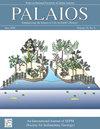木塞还是海狸坝?加拿大高北极地区上新世生物、沉积物和景观的相互作用
IF 1.5
4区 地球科学
Q2 GEOLOGY
引用次数: 3
摘要
摘要:上新世中期(桑古世,约3.9 Ma),加拿大高北极部分地区的年平均气温比现在高14-22°C,并支持多种北方针叶林。这片植被覆盖的极地地区的景观留下了一个破碎的沉积记录,这些记录横跨加拿大北极群岛的几个岛屿,形成了波弗特地层和相关地层。来自这些地层的古生态信息为了解上新世环境提供了一个高保真的窗口,而突出的化石遗址则为了解新生代哺乳动物的进化提供了无与伦比的见解。值得注意的是,许多地层揭示了气候温暖的北极地区生命-沉积物相互作用的证据,最显著的形式是广泛的木质碎屑和植物碎屑沉积。本文介绍了原始的野外数据,这些数据提炼了来自非现实的北极高纬度森林的植物碎屑堆积的沉积学背景,最值得注意的是在埃尔斯米尔岛中部“高阶地沉积物”的“Fyles叶床”和“海狸池”化石遗址。前者是一个保存非常完好的富叶矿床,是古地形不整合之上的湖泊、河流三角洲和沼泽沉积相组合复合体的一部分。后者在泥炭层中发现了有牙齿痕迹的木质碎片,泥炭层中还含有丰富的脊椎动物和植物化石,包括大量已灭绝的海狸群二足纲的遗骸。通过与英国全新世海狸坝相的对比,我们提供了沉积学数据,提供了间接证据,证明海狸塘的木质碎屑沉积物可以记录该属的水坝建设。在高北极地区的上新世,木质碎屑堆积代表了一系列生物沉积沉积物和地貌,包括矿坑、漂流物、木质河床和可能的海狸坝,这有助于确定哺乳动物化石遗址的背景,为高纬度森林提供相模型,并揭示了在一个消失的世界中生命与沉积之间的相互作用,这可能是不久的将来的模拟。本文章由计算机程序翻译,如有差异,请以英文原文为准。
WOOD JAMS OR BEAVER DAMS? PLIOCENE LIFE, SEDIMENT AND LANDSCAPE INTERACTIONS IN THE CANADIAN HIGH ARCTIC
Abstract: During the mid-Pliocene (Zanclean, ca. ∼ 3.9 Ma), parts of the Canadian High Arctic experienced mean annual temperatures that were 14–22°C warmer than today and supported diverse boreal-type forests. The landscapes of this vegetated polar region left behind a fragmented sedimentary record that crops out across several islands in the Canadian Arctic Archipelago as the Beaufort Formation and correlative strata. Paleoecological information from these strata provides a high-fidelity window onto Pliocene environments, and prominent fossil sites yield unparalleled insights into Cenozoic mammal evolution. Significantly, many of the strata reveal evidence for life-sediment interactions in a warm-climate Arctic, most notably in the form of extensive woody debris and phytoclast deposits. This paper presents original field data that refines the sedimentological context of plant debris accumulations from the anactualistic High Arctic forests, most notably at the ‘Fyles Leaf Beds’ and ‘Beaver Pond’ fossil-bearing sites in the ‘high terrace deposits’ of central Ellesmere Island. The former is a remarkably well-preserved, leaf-rich deposit that is part of a complex of facies associations representing lacustrine, fluvio-deltaic and mire deposition above a paleotopographic unconformity. The latter yields tooth-marked woody debris within a peat layer that also contains a rich assemblage of vertebrate and plant fossils including abundant remains from the extinct beaver-group Dipoides. Here we present sedimentological data that provide circumstantial evidence that the woody debris deposit at Beaver Pond could record dam-building in the genus, by comparing the facies motif with new data from known Holocene beaver dam facies in England. Across the Pliocene of the High Arctic region, woody debris accumulations are shown to represent an array of biosedimentary deposits and landforms including mires, driftcretions, woody bedforms, and possible beaver dams, which help to contextualize mammal fossil sites, provide facies models for high-latitude forests, and reveal interactions between life and sedimentation in a vanished world that may be an analogue to that of the near-future.
求助全文
通过发布文献求助,成功后即可免费获取论文全文。
去求助
来源期刊

Palaios
地学-地质学
CiteScore
2.80
自引率
12.50%
发文量
40
审稿时长
6 months
期刊介绍:
PALAIOS is a monthly journal, founded in 1986, dedicated to emphasizing the impact of life on Earth''s history as recorded in the paleontological and sedimentological records. PALAIOS disseminates information to an international spectrum of geologists and biologists interested in a broad range of topics, including, but not limited to, biogeochemistry, ichnology, paleoclimatology, paleoecology, paleoceanography, sedimentology, stratigraphy, geomicrobiology, paleobiogeochemistry, and astrobiology.
PALAIOS publishes original papers that emphasize using paleontology to answer important geological and biological questions that further our understanding of Earth history. Accordingly, manuscripts whose subject matter and conclusions have broader geologic implications are much more likely to be selected for publication. Given that the purpose of PALAIOS is to generate enthusiasm for paleontology among a broad spectrum of readers, the editors request the following: titles that generate immediate interest; abstracts that emphasize important conclusions; illustrations of professional caliber used in place of words; and lively, yet scholarly, text.
 求助内容:
求助内容: 应助结果提醒方式:
应助结果提醒方式:


